I am trying to create a subwindow in an MDI area in pyqt5, using a .ui file for my main window. When I trigger the action to show the subwindow, it shows up as a separate window (not docked in the MDI area as intended). I've tried adding the subwindow via this tutorial (codeloop.org MDI Area Tutorial) and it works fine, but I couldn't replicate it by loading the .ui file.
app.py
import os
import sys
from PyQt5 import QtCore, QtWidgets, uic
scriptPath = os.path.dirname(os.path.realpath(__file__))
uiFile = scriptPath + '\\' + 'mainwindow.ui'
class MainWindow(QtWidgets.QMainWindow):
def __init__(self, *args, **kwargs):
super(MainWindow, self).__init__(*args, **kwargs)
self.initUI()
def initUI(self):
#load the UI page
self.ui_main = uic.loadUi(uiFile, self)
self.action1.triggered.connect(lambda: self.fileBarTrig('test'))
def fileBarTrig(self,p):
print(p)
self.subwindow.show()
self.mdiArea.tileSubWindows()
def main():
app = QtWidgets.QApplication(sys.argv)
main = MainWindow()
main.show()
sys.exit(app.exec_())
if __name__ == '__main__':
main()
mainwindow.ui
<?xml version="1.0" encoding="UTF-8"?>
<ui version="4.0">
<class>MainWindow</class>
<widget class="QMainWindow" name="MainWindow">
<property name="windowModality">
<enum>Qt::NonModal</enum>
</property>
<property name="geometry">
<rect>
<x>0</x>
<y>0</y>
<width>800</width>
<height>600</height>
</rect>
</property>
<property name="windowTitle">
<string>MainWindow</string>
</property>
<widget class="QWidget" name="centralwidget">
<layout class="QVBoxLayout" name="verticalLayout">
<item alignment="Qt::AlignLeft">
<widget class="QMdiArea" name="mdiArea">
<property name="activationOrder">
<enum>QMdiArea::CreationOrder</enum>
</property>
<property name="viewMode">
<enum>QMdiArea::SubWindowView</enum>
</property>
<property name="documentMode">
<bool>false</bool>
</property>
<widget class="QWidget" name="subwindow">
<property name="windowTitle">
<string>subwindow</string>
</property>
<widget class="QPushButton" name="pushButton">
<property name="geometry">
<rect>
<x>70</x>
<y>80</y>
<width>75</width>
<height>23</height>
</rect>
</property>
<property name="text">
<string>help</string>
</property>
</widget>
</widget>
<widget class="QWidget" name="subwindow_2">
<property name="windowTitle">
<string>Subwindow</string>
</property>
</widget>
</widget>
</item>
</layout>
</widget>
<widget class="QMenuBar" name="menubar">
<property name="geometry">
<rect>
<x>0</x>
<y>0</y>
<width>800</width>
<height>21</height>
</rect>
</property>
<widget class="QMenu" name="menuFile">
<property name="title">
<string>File</string>
</property>
<addaction name="action1"/>
</widget>
<addaction name="menuFile"/>
</widget>
<widget class="QStatusBar" name="statusbar"/>
<action name="action1">
<property name="text">
<string>1</string>
</property>
</action>
</widget>
<resources/>
<connections/>
</ui>
app.py running with undocked subwindow
